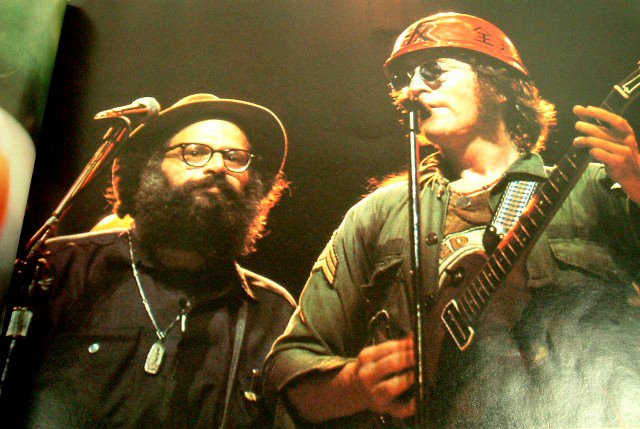“He was searching for something much higher, much deeper. It does seem like he already had some Indian background in him. Otherwise, it’s hard to explain how he got so attracted to a particular type of life and philosophy, even religion. It seems very strange, really. Unless you believe in reincarnation.”
Ravi Shankar
 Ravi Shankar and George Harrison
Ravi Shankar and George Harrison
By the mid-1960s George Harrison had become an admirer of Indian culture and mysticism, introducing it to the other Beatles. During the filming of Help! (Richard Lester, 1965) in the Bahamas, they met the founder of Sivananda Yoga, Vishnudevananda Saraswati, who gave each of them a signed copy of his book, The Complete Illustrated Book of Yoga. Between the end of the last Beatles tour in 1966 and the beginning of the Sgt Pepper recording sessions, he made a pilgrimage to Bombay with his wife Pattie Boyd, where he studied sitar, met several gurus, and visited various holy places. In 1968 he travelled to Rishikesh in northern India with the other Beatles to study meditation with Maharishi Mahesh Yogi. Harrison’s use of psychedelic drugs encouraged his path to meditation and Hinduism. He commented: “For me, it was like a flash. The first time I had acid, it just opened up something in my head that was inside of me, and I realized a lot of things. I didn’t learn them because I already knew them, but that happened to be the key that opened the door to reveal them. From the moment I had that, I wanted to have it all the time – these thoughts about the yogis and the Himalayas, and Ravi’s music.”
By 1965’s Rubber Soul, Harrison had begun to lead the other Beatles into folk rock through his interest in The Byrds and Bob Dylan, and towards Indian classical music through his use of the sitar on Norwegian Wood (This Bird Has Flown). He later called Rubber Soul his “favourite [Beatles] album”. Revolver (1966) included three of his compositions: Taxman, Love You To and I Want to Tell You. His introduction of the drone-like tambura part on Lennon’s Tomorrow Never Knows exemplified the band’s ongoing exploration of non-Western instruments. The tabla-driven Love You To was the Beatles’ first genuine foray into Indian music. According to the ethnomusicologist David Reck, the song set a precedent in popular music as an example of Asian culture being represented by Westerners respectfully and without parody. Harrison continued to develop his interest in non-Western instrumentation, playing swarmandal on Strawberry Fields Forever.
During the Beatles’ American tour in August 1965, Harrison’s friend David Crosby of The Byrds introduced him to Indian classical music and the work of sitar maestro Ravi Shankar. Harrison described Shankar as “the first person who ever impressed me in my life … and he was the only person who didn’t try to impress me.” Harrison became fascinated with the sitar and immersed himself in Indian music. According to Peter Lavezzoli, Harrison’s introduction of the instrument on the Beatles’ song “Norwegian Wood” “opened the floodgates for Indian instrumentation in rock music, triggering what Shankar would call ‘The Great Sitar Explosion’ of 1966–67”. Lavezzoli described Harrison as “the man most responsible for this phenomenon”.


































